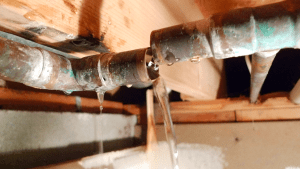What are your opinions about Detecting hidden plumbing leaks?

Early detection of leaking water lines can minimize a possible catastrophe. Some small water leaks might not be noticeable.
1. Take A Look At the Water Meter
Every house has a water meter. Checking it is a proven way that helps you find leaks. For beginners, turn off all the water resources. Ensure no person will certainly purge, utilize the tap, shower, run the washing equipment or dishwashing machine. From there, go to the meter as well as watch if it will transform. Considering that nobody is using it, there need to be no motions. If it moves, that indicates a fast-moving leak. Also, if you identify no changes, wait an hour or more and check back once again. This suggests you may have a sluggish leak that can also be below ground.
2. Inspect Water Usage
If you detect sudden adjustments, in spite of your consumption being the very same, it implies that you have leaks in your plumbing system. An abrupt spike in your bill suggests a fast-moving leakage.
A steady boost every month, even with the very same routines, reveals you have a slow leakage that's likewise gradually intensifying. Call a plumber to completely inspect your home, especially if you feel a warm area on your floor with piping beneath.
3. Do a Food Coloring Test
When it comes to water consumption, 30% comes from toilets. If the shade somehow infiltrates your dish throughout that time without flushing, there's a leak between the tank and dish.
4. Asses Outside Lines
Do not fail to remember to examine your exterior water lines as well. Test faucets by connecting a garden pipe. Ought to water seep out of the link, you have a loose rubber gasket. Change this and ensure all links are tight. If you've obtained a sprinkler system, it will certainly help get it properly took a look at and preserved each year. One tiny leak can squander lots of water and also spike your water bill.
5. Analyze the circumstance as well as inspect
Homeowners need to make it a practice to examine under the sink counters and even inside cupboards for any kind of bad odor or mold and mildew development. These two red flags suggest a leak so timely interest is required. Doing routine examinations, even bi-annually, can save you from a significant issue.
Extra notably, if you recognize your house is already old, maintain a watchful eye on your heating units, hose pipes, pipelines and so on. Look for discolorations as well as damaging as a lot of appliances as well as pipes have a life expectancy. They will certainly additionally naturally weaken because of tear and wear. If you think leaking water lines in your plumbing system, don't await it to rise. Call a specialist plumber immediately so you don't wind up with a dreadful mess in your home.
Early detection of dripping water lines can mitigate a potential catastrophe. Some little water leaks might not be noticeable. Checking it is a proven way that assists you uncover leakages. One tiny leak can lose bunches of water and spike your water bill.
If you presume dripping water lines in your plumbing system, do not wait for it to rise.
WARNING SIGNS OF WATER LEAKAGE BEHIND THE WALL
PERSISTENT MUSTY ODORS
As water slowly drips from a leaky pipe inside the wall, flooring and sheetrock stay damp and develop an odor similar to wet cardboard. It generates a musty smell that can help you find hidden leaks.
MOLD IN UNUSUAL AREAS
Mold usually grows in wet areas like kitchens, baths and laundry rooms. If you spot the stuff on walls or baseboards in other rooms of the house, it’s a good indicator of undetected water leaks.
STAINS THAT GROW
When mold thrives around a leaky pipe, it sometimes takes hold on the inside surface of the affected wall. A growing stain on otherwise clean sheetrock is often your sign of a hidden plumbing problem.
PEELING OR BUBBLING WALLPAPER / PAINT
This clue is easy to miss in rooms that don’t get much use. When you see wallpaper separating along seams or paint bubbling or flaking off the wall, blame sheetrock that stays wet because of an undetected leak.
BUCKLED CEILINGS AND STAINED FLOORS
If ceilings or floors in bathrooms, kitchens or laundry areas develop structural problems, don’t rule out constant damp inside the walls. Wet sheetrock can affect adjacent framing, flooring and ceilings.
https://www.servicemasterbyzaba.com/blog/how-to-detect-water-leakage-in-walls/

Hopefully you enjoyed reading our piece on Locating water leaks. Thanks so much for spending some time to read through our content. Those who liked our article please do not forget to share it. We love reading our article about Top leak detection hacks.
Comments on “6 Ways to Locate Surprise Water Leakages in Your Residence”